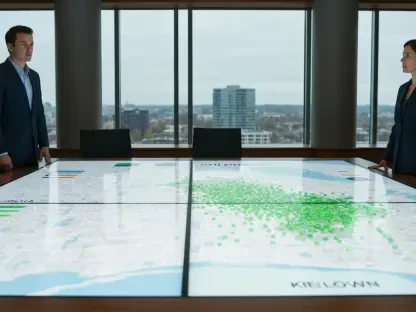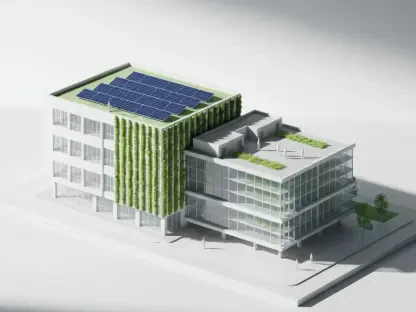In Australia, a profound housing crisis has gripped the nation, leaving roughly one-third of the population unable to achieve the dream of homeownership due to soaring prices and stagnant wages, while conventional approaches struggle to keep pace with demand. As a result, a new model known as build-to-rent (BTR) has stepped into the spotlight. These purpose-built, large-scale apartment complexes are designed specifically for long-term rental rather than immediate sale, often featuring high-quality amenities and a promise of stability for tenants. This emerging trend raises a critical question: could BTR provide a meaningful solution to the affordability and supply challenges that define the current housing landscape? With renters facing escalating costs and shrinking options, the stakes couldn’t be higher.
BTR sits within the broader framework of purpose-built rental accommodation (PBRA), offering a distinct alternative to the traditional build-to-sell model by focusing on tenant needs over quick developer profits. From sleek luxury towers in urban centers to community-driven affordable projects, this housing approach is gaining momentum in major cities like Melbourne and Sydney. Yet, doubts persist about its ability to address the needs of all income brackets, especially those most vulnerable. Melbourne has positioned itself as a leader in BTR development, showcasing a range of projects, while Sydney lags due to prohibitive land costs, though government initiatives are spurring progress. This exploration delves into the potential of BTR to reshape rental living, weighing its strengths against persistent systemic hurdles.
Understanding Build-to-Rent in Today’s Market
Defining BTR in the Australian Context
Build-to-rent (BTR) represents a shift in housing development, focusing on creating large-scale apartment complexes specifically for long-term rental rather than individual ownership or quick resale. Unlike the dominant build-to-sell model, BTR prioritizes tenant stability, often incorporating premium features like fitness centers, communal gardens, and coworking spaces to enhance the living experience. Within the spectrum of purpose-built rental accommodation (PBRA), BTR spans from high-end market-rate offerings to more affordable or social housing initiatives, reflecting a versatile approach. Its rise in Australia comes at a time when the housing crisis has intensified, with homeownership becoming an unattainable goal for many. This model seeks to redefine rental living by providing a sense of permanence, challenging the transient nature often associated with renting.
The significance of BTR lies in its potential to address a structural gap in the housing market. As urban populations swell and property prices soar, particularly in cities like Melbourne and Sydney, the demand for quality rental options has surged. BTR projects are often backed by institutional investors who see long-term value in rental income over speculative sales, which can stabilize the sector. However, while the concept is gaining traction, it remains a relatively new player in the Australian context, with varying degrees of adoption across states. Understanding BTR’s place within PBRA helps frame its role in tackling broader housing challenges, though questions about scalability and inclusivity linger as key points of debate.
A Growing Need for Rental Solutions
A significant portion of Australians—estimated at around one-third—are now permanent renters, priced out of homeownership by a combination of high property costs and economic pressures. This demographic, ranging from young professionals to families and older adults, often faces insecurity in the rental market, with short-term leases and unpredictable rent hikes creating instability. BTR emerges as a response to this growing need, offering longer tenancy agreements and a focus on quality living environments that can mimic the permanence of owning a home. This shift is particularly relevant in urban centers where housing supply struggles to match population growth, exacerbating the crisis for those unable to buy.
Beyond mere shelter, the demand for rental solutions reflects a deeper societal change, as more people accept renting as a long-term lifestyle rather than a temporary step. BTR developments aim to cater to this shift by providing not just apartments, but curated communities with amenities that foster connection and comfort. This approach contrasts sharply with the often impersonal and maintenance-heavy experience of traditional rentals. Yet, the challenge remains in ensuring that BTR can reach beyond a niche market to serve a broader renter base, especially those with limited financial means. Addressing this need could position BTR as a cornerstone of housing reform, provided it evolves to meet diverse demands.
Challenges and Opportunities in Build-to-Rent
Affordability: The Elephant in the Room
Affordability stands as the most pressing barrier to BTR’s potential as a widespread housing solution in Australia. Many early BTR projects, particularly in prime urban locations, target higher-income renters, with rents often exceeding local market rates due to premium designs and extensive amenities. This focus on upscale offerings, while attractive to certain demographics like young professionals or empty nesters, leaves a significant portion of the population—those most affected by the housing crisis—out of reach. The gap between what BTR often delivers and what lower-income renters can afford raises critical questions about whether this model can truly address the core of the affordability crisis without substantial changes to its structure.
However, not all BTR developments follow the luxury path, and some offer a glimmer of hope for broader accessibility. Projects like Nightingale Marrickville in Sydney demonstrate how innovative design and partnerships with non-profit organizations can reduce costs, offering rents at least 20% below market levels. By forgoing expensive features like underground parking and utilizing shared resources, such initiatives show that affordability is achievable within the BTR framework. Yet, scaling these models to meet widespread demand remains a daunting task, as land costs and development expenses continue to pose obstacles. Without targeted interventions, the risk is that BTR could remain a solution for the few rather than the many.
Design and Community as Key Pillars
A defining strength of BTR lies in its emphasis on architectural innovation and thoughtful design, aiming to elevate the rental experience beyond basic accommodation. Projects often feature spacious apartment layouts, sustainable materials, and communal spaces like rooftop terraces or wellness facilities that encourage interaction among residents. Realm Caulfield in Melbourne, for instance, integrates mixed-use elements such as retail spaces and public plazas into a suburban setting, creating a campus-like environment that feels like a true home. This focus on livability seeks to counter the stigma of renting as a lesser option, offering tenants a sense of pride and permanence in their living spaces.
Equally important is the role of community-building within BTR developments, which sets them apart from traditional rental properties. Shared amenities are not mere add-ons but are integral to fostering social connections, addressing the isolation that can accompany urban living. Redfern Place in Sydney, with its upcoming focus on social and affordable housing, exemplifies this by incorporating community hubs and culturally sensitive design principles to engage residents. Such efforts highlight how BTR can redefine rental housing as a platform for social inclusion, though the challenge lies in ensuring these benefits are accessible across income levels. Balancing design quality with cost considerations remains a pivotal factor in realizing this vision on a larger scale.
The Role of Policy and Investment
Government Support: A Double-Edged Sword
Government intervention has played a crucial role in propelling the growth of BTR in Australia, particularly in high-cost markets where private developers might otherwise shy away. Policies such as tax incentives for projects that include affordable housing components, alongside public-private partnerships, have enabled significant developments to take shape. Indi Sydney, located above Gadigal station in Sydney’s CBD, stands as a prime example of how collaboration between government and developers can bring BTR to fruition in challenging urban environments. These initiatives provide a framework for increasing housing supply, offering a potential lifeline to renters seeking stability in competitive markets.
Yet, this support comes with contention, as critics argue that public resources might be better directed toward traditional public housing to serve the most disadvantaged. The debate centers on whether incentivizing BTR risks diverting attention from systemic issues, such as the chronic underfunding of social housing programs. While government-backed projects can spur innovation and attract investment, there’s a lingering concern about equity—ensuring that benefits reach beyond middle- and high-income renters to those in greatest need. Striking a balance between fostering BTR as a market solution and prioritizing broader housing equity remains a complex policy challenge that demands careful navigation.
Institutional Backing for Long-Term Growth
Institutional investment is increasingly recognized as a stabilizing force for the BTR sector, providing the financial muscle needed to scale projects across Australia. Large investors, including pension funds and real estate firms, view BTR as a reliable long-term asset due to consistent rental income streams, especially in a market where homeownership rates are declining. This influx of capital can accelerate development, enabling projects to move from concept to completion more swiftly. The trend offers a promising avenue for expanding housing supply, potentially bridging gaps between private market offerings and public needs if channeled effectively.
The involvement of institutional players also brings a level of professionalism and longevity to the sector, encouraging standardized quality and tenant-focused management practices. However, the focus on profitability can sometimes clash with social objectives, as investors may prioritize high-return projects over those serving lower-income groups. Redirecting some of this financial backing toward affordable or mixed-tenure developments could amplify BTR’s impact, creating a more inclusive housing landscape. The challenge lies in aligning investor interests with policy goals to ensure that growth benefits a wide spectrum of renters, rather than reinforcing existing inequalities in access to quality housing.
Case Studies: Diverse Approaches to BTR
Luxury vs. Accessibility in Melbourne and Sydney
The spectrum of BTR projects in Australia reveals a stark contrast between luxury offerings and those striving for accessibility, reflecting varied priorities within the sector. In Melbourne, Realm Caulfield stands out as a pioneering suburban BTR development, comprising hundreds of apartments with high-end amenities like coworking spaces and play areas, yet its rents remain above local averages, catering primarily to middle- and higher-income tenants. Similarly, Indi Sydney in Sydney’s CBD targets empty nesters and professionals with wellness-focused features and premium pricing. These market-rate projects highlight BTR’s appeal to specific demographics but underscore a disconnect from the broader affordability crisis gripping the nation.
On the flip side, the push for accessibility in some BTR initiatives offers a counterpoint to the luxury trend, though it remains limited in scope. While projects like Realm Caulfield and Indi Sydney dominate headlines for their scale and design, they often sidestep the needs of lower-income renters who form a significant portion of the housing crisis demographic. The question arises whether such upscale developments can coexist with the urgent demand for affordable options, or if they risk overshadowing more inclusive efforts. Examining these contrasting approaches reveals the inherent tension in BTR’s evolution—balancing market appeal with the societal need for equitable housing solutions across urban centers.
Innovative Models for Social Impact
Amid the dominance of market-driven BTR, certain projects showcase how the model can pivot toward social and affordable housing goals, offering valuable lessons for broader application. Nightingale Marrickville in Sydney, developed through a partnership with a non-profit, prioritizes affordability by cutting costs on non-essential features like underground parking and using shared resources such as communal laundries. Its ballot system further targets vulnerable groups, ensuring access for those often excluded from quality housing. This approach demonstrates that BTR can address systemic inequities when paired with innovative cost-saving strategies and a clear social mission.
Redfern Place in Sydney takes this a step further, focusing entirely on social, affordable, and disability-support housing in its upcoming development, projected to be completed within the next few years. By integrating community hubs and engaging residents through culturally sensitive design, the project aims to create a “community of communities” that fosters inclusion. Such initiatives highlight BTR’s adaptability within the PBRA spectrum, showing how it can shift from profit-driven models to ones prioritizing social impact. However, replicating these efforts on a national scale remains a hurdle, as funding and policy support must align to elevate these models from exceptions to the norm in addressing housing needs.
Scaling Build-to-Rent: Barriers to Overcome
High Costs and Market Limitations
Scaling BTR to meet Australia’s vast housing demand faces significant practical barriers, particularly in high-cost markets like Sydney where land prices pose a formidable obstacle. The expense of acquiring suitable sites in urban centers often limits developers to premium projects that cater to wealthier renters, as the financial returns must justify the initial outlay. This dynamic slows the adoption of BTR in areas where rental demand is highest, creating a mismatch between supply and need. Melbourne, while ahead in BTR development, also grapples with rising costs that threaten to constrain growth, raising concerns about the model’s ability to expand beyond select cities or demographics.
Beyond land costs, market limitations such as regulatory hurdles and construction expenses further complicate the picture, often deterring smaller developers from entering the BTR space. The reliance on large institutional investors or government support to offset these challenges can create a bottleneck, as not all projects secure such backing. Additionally, public perception of BTR as a niche or luxury option can hinder broader acceptance, limiting its reach. Addressing these barriers requires a multifaceted approach, from zoning reforms to financial incentives, to ensure that BTR can grow in a way that meets the diverse needs of renters across the country, rather than remaining confined to specific pockets.
Balancing Profit and Social Good
The tension between market viability and social impact lies at the heart of BTR’s scalability challenges, as developers and investors often prioritize profitability over addressing the needs of lower-income Australians. High-end projects, while financially lucrative and attractive to institutional backers, tend to exclude the very populations most affected by the housing crisis, reinforcing existing inequalities. This focus on returns can overshadow the potential for BTR to serve as a tool for social good, particularly when affordable housing components are deprioritized in favor of maximizing revenue in competitive urban markets.
Finding a balance requires innovative frameworks that align profit motives with societal benefits, such as mandating a percentage of affordable units in BTR developments or offering greater incentives for mixed-tenure projects. Models like Nightingale Marrickville and Redfern Place provide blueprints for how this can work, but their impact remains limited without systemic change. Policymakers and stakeholders must grapple with how to incentivize developers to prioritize inclusivity while ensuring financial sustainability. Only through such alignment can BTR evolve from a segmented solution into a cornerstone of Australia’s housing strategy, capable of delivering both economic and social value over the long term.









